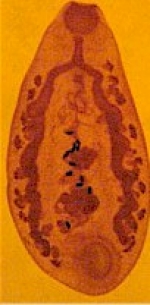NEIHPID
North-East India Helminth Parasite Information Database
Recently added
Parasites
Molecular Data
Orthocoelium streptocoelium (Yamaguti Yamaguti) Fischoeder 1910
Taxonomy
Platyhelminthes »
TREMATODA »
Digenea »
Paramphistomidae Fischoeder, 1901 »
Orthocoeliinae Price et McIntosh, 1953 »
Orthocoelium (Stiles et Goldberger, 1910) Price et McIntosh, 1953 »
Orthocoelium streptocoelium (Fischoeder 1910), Yamaguti 1971
Synonyms
(Ceylonocotyle Näsmark, 1937; Cochinocotyle Gupta et Gupta, 1970)
Host
Bos (indicus), Capra (hircus), Ovis (aries)
Habitat
Rumen
Locality
Guwahati (Assam), Silchar (Assam), Shillong (Meghalaya), Kohima (Nagaland)
Description
Body elongated, conical, 4.61-7.36 mm in length, 2.44-3.25 mm in greatest width, ratio of body width to body length 1:1.88 -1:2.30. Acetabulum sub-terminal, 1.08-1.49 mm in external diameter; ratio to body length 1:4.26-1:5.87; of streptocoelium type (sensu Näsmark, 1937) in median sagittal section; units of circular muscles on lateral sides as follows :d.e.c.m. 16-20, d.i.c.m. 28-33, v.e.c.m. 14-17, v.i.c.m. 27-33, m.e.c.m. 5-9. Pharynx 0.54-0.81 mm in length, 0.45-0.75 mm in width; ratio to body length 1:8.53-1:11.84; of calicophoron type (sensu Dinnik, 1964) in median sagittal section. Oesophagus 0.49-0.72 mm long, musculature of its wall thickened at its posterior end to form a sphincter. Caeca lateral, forming few dorso-ventral bends, reaching to acetabulum. Testes lobed, tandem; anterior testis 0.48-0.84 mm in length, 0.60-0.88 mm in width; posterior testis 0.38-0.63 mm in length, 0.58-0.91 mm in width. Seminal vesicle thin walled, coiled; pars musculosa well developed. Ovary sub spherical, 0.23-0.36 mm by 0.36- 0.54 mm, posterior to testes, close to Mehlis' gland. Laurer's canal not crossing excretory vesicle or duct, opening on dorsal surface 0.31-0.45 mm anterior to excretory pore. Vitellaria lateral, extending from level of oesophagus to acetabulum. Eggs 0.108-0.117 mm by 0.054-0.067 mm. Terminal genitalium of streptocoelium type (sensu Näsmark, 1937) in median sagittal section, genital pore opening ventrally, posterior to oesophageal bifurcation.
Remarks
O. streptocoelium has earlier been reported from Bos indicus and Bubalus bubalis in Ernakulam, South India (Gupta and Nakhasi, 1977) and from Ovis aries and Capra hircus in Himachal Pradesh (Tandon and Sharma, 1981)
The present observations differ from those of Gupta and Nakhasi (1977) in histological details of acetabulum and pharynx. These authors observed the acetabulum to be of paramphistomum type in outline and the pharynx, to be of paramphistomum type. However, the present observations tally with those of Eduardo (1985b) in all major features, except minor differences in measurements of different body organs and the number of acetabular muscle units.
Helminthological collections record
NEHU/Z - TM/15
Specimen Type
Holotype: W7790/1 in Zoological survey of India, Kolkata.
References
Gupta, N. K. and Nakhasi, U. (1977). On some amphistomid parasites from India (Parts I & II). Revista Iberica de Parasitologia. 37:pp 205-225, 252-272.
Tandon ,V. and Sharma, V. (1981). Amphistome fauna of ruminants in Himachal Pradesh. Indian Journal of Parasitology .5:pp 241-245.
Eduardo ,S .L. (1985b). The taxonomy of the family Paramphistomidae Fischoeder, 1901 with special reference to the morphology of species occurring ruminants. VI. Revision of the genus Orthocoelium (Stiles& Goldberger, 1910) Price &McIntosh, 1953. Systematic Parasitology.7:pp 125-158.



.jpg)
